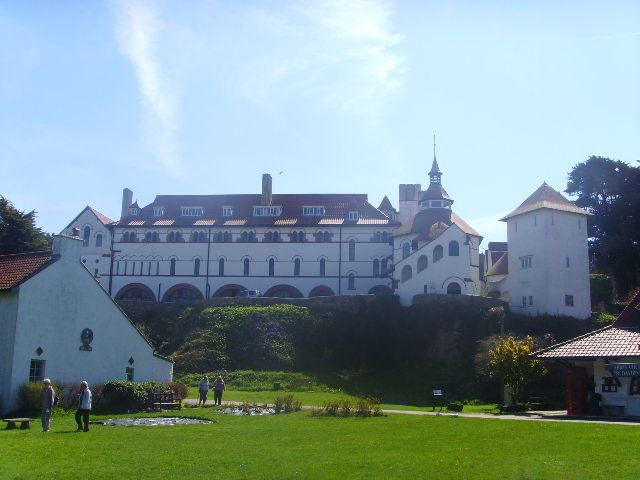Country Wales Founded 1910 Heritage designation Listed building | Denomination Roman Catholic Church Functional status Active Phone +44 7879 711040 Deanery Pontypridd | |
 | ||
Website www.caldey-island.co.uk Similar Caldey Island, Caldey Lighthouse, Tenby Museum and Art G, Ramsey Island, Manorbier Castle | ||
Caldey abbey and grounds slideshow
Caldey Abbey is an abbey and monastery of the Cistercian order of the Strict Observance (commonly called Trappists), situated on the island of Caldey, south of Tenby on the Welsh coast of Pembrokeshire.
Contents
- Caldey abbey and grounds slideshow
- History
- Monastic life
- Lavender perfume
- Architecture and fittings
- References
Caldey Island has been known as one of the centres of Cistercian activity since Celtic times and thrived during medieval Europe. However, the current abbey was built in 1910 by Anglican Benedictine monks. At the time of building, the abbey was called "the greatest phenomenon in the Anglican community at the present time". The abbey passed to the Cistercian order in 1929. Today, the monks of Caldey Abbey are known for their lavender perfume, shortbread and chocolate production, and opened a shop on the Internet in 2001.
History
A Celtic monastery was founded on the island in the sixth century, and a Benedictine foundation existed from 1136 until the dissolution of the monasteries in 1536 (Benedictian monks were from the St Dogmaels Abbey located on the River Teifi). Pyro was the abbey's first abbot; Saint Samson was also one of Caldey Abbey's pioneer abbots.
William Done Bushell offered the island to Dom Aelred Carlyle in 1900. An Anglican Benedictine community, led by Carlyle, arrived six years later in 1906, and built the current abbey in the Italian style with assistance from Lord Halifax and others between 1906 and 1910. Initially a row of cottages were built for the people working on the building; hence the abbey was named as "cottage Monastery." The chapel was added in 1910. Three years later the monks were received by the Roman Catholic Church, except for a small Anglican remnant which left Caldey and moved into Abbey House, next to Pershore Abbey, Worcestershire. This was a house which had belonged to Caldey Abbey, but was returned in 1913 to its original, Anglican donor. The Anglican Benedictine community moved on from Pershore to Nashdom Abbey in 1926.
The Catholic Benedictines left Caldey in 1925, due to financial difficulties, and by 1928 moved to Prinknash Abbey. The much stricter Cistercian Order, who now occupy the abbey, came in 1929 from Scourmont Abbey in Belgium. The monastery was rebuilt in 1940 after a fire. The monks are now financially self-reliant, supporting themselves with tourism and sale of perfumes.
Monastic life
Perfume, shortbread and chocolate production all provide income for the monks, as well as the sale of prime beef. The monastery opened an internet shop in 2001. Their lavender perfume is said to be "simply the best lavender soliflore on earth" by the perfume critic Luca Turin. Chocolate is also sold under the "Abbot's Kitchen" brand. The monastery used to operate a now-defunct dairy which would sell iced confectionery and cake.
Lavender perfume
Profuse growth of wild lavender flowers in the Caldey Island prompted the monks of the abbey to create scents with new fragrances. They branded the scents and marketed them with the brand name “Caldey Abbey Perfumes.” With booming demand for this brand of scent there was need to import scent oil from outside the island. The scent is now manufactured throughout the year and is partly based on the island's gorse.
Architecture and fittings
The structure is considered to be the most complete example of the Arts and Crafts style in the country. It was also John Coates Carter's largest project. The roofs are of white roughcast with red tiling, while the large basement arches are of brick. The abbey church has a south tower, with five side-windows, and has a "tapering" tower with primitive crenellations. The windows are simple, with lead glazing. Originally the fittings included silver and ebony altar decorations and other luxurious items, but many were destroyed in the 1940 fire. The refectory of the Abbey was made from fine timber, and although inspired by an ancient pattern, it was modern in design. Two large water tanks underground and a narrow water shaft eliminate the threat of water scarcity in dry seasons.
It is a Grade II* listed building.
